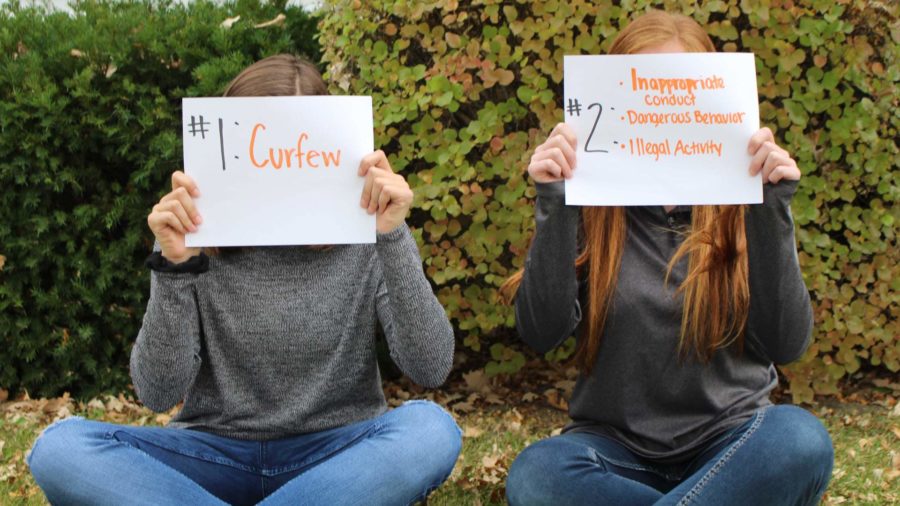Read the Fine Print
1. Closely examine the details of a deal or contract to make sure you understand them.
October 28, 2016
The “Code of Conduct” is the document that every athlete in the school needs to sign, no matter their grade level or level of competition. There is no greater feeling of defeat than asking for a clearance card and realizing you and your parent have yet to sign the “Code of Conduct.” Naturally, the athlete will rip the back page from the stapled papers and hand it off to their parent or guardian for them to sign without ever reading the attached packet. Most may think they are signing a waiver to secure safety for their child, while giving them permission to compete in their sport, which is a primary concern of the article; however, there is a lot more to the document that the student body and their families may not realize.
There are 13 main points expressed in the “Code of Conduct,” starting with curfew and ending with concussion information. A much wider range of guidelines is in the document that everyone may not realize; it’s the no-brainers like school rules and eligibility requirements, but also a couple topics that may seem strange, like rules on hazing and lines of communication. There is so much packed into the “Code of Conduct” that may seem unimportant, but has the common goal of protecting the students.
The nine-page document is packed with information that not too many athletes are aware of at first glance. Senior Marshall King had an idea of what is included in the “Code of Conduct,” but was not too sure of exactly what was in the information without reading more closely.
“I think it has something to do with being able to search students,” King said. “And by signing it, I give full consent to whatever they say they want to do.”
King admitted to never reading the “Code of Conduct,” just like many other athletes admit to as well. The document doesn’t so much focus on being able to search the students; however, random drug tests are allowed to occur whenever the school chooses to participate. That means once a student signs the “Code of Conduct,” it now opens them to being chosen for a random drug test, which they are not allowed to deny.
“Athletics and parking on campus are a privilege and not a right,” SAP Coordinator and paraprofessional Emily Sobczak wrote in an email. “We as a district can require different things of students to do if it is something that goes beyond the scope of the 8-hour educational day. Having drug testing in district for the last 10-ish years has been a way to show that we hold our athletes and school representatives to higher standards than just a ‘pay-to-play’; we do it because we care. It is also a great excuse for student-athletes to turn down any temptations or peer pressures that may be presented to them because they can say, ‘Sorry, I can’t, I get drug tested at school.’”
A signed copy of the “Code of Conduct” lasts quite a long time. It expires a year from the start of the sporting season in which the athlete last played, which is another caveat some athletes may not realize or choose to disregard—especially in the months school is not in session.
While the majority of the document addresses the consequences of drugs and alcohol, there is a lot more information to know from reading it thoroughly and critically.
Eligibility is another main focus; in Community High School District 117, coaches tell their athletes, “you are a student-athlete,” emphasizing the word student coming before athlete. Academics are the reason an athlete is in school, and sports are considered a luxury, so athletes must do well in school before they do well in a sport. Students must maintain a minimum of a 2.0 GPA and be passing at least five classes; if an athlete drops below that, the student will be put on academic probation for three weeks, constantly working with the coach, parents and staff to help raise their GPA.
“I think the ‘Code of Conduct’ explains what is expected of you being a Sequoit athlete, and what criteria you need to meet in order to be eligible to play a sport,” junior Katherine Sorensen said.
Just like King, Sorensen has not read the “Code of Conduct” either, but she had a good idea of what is packed into the nine pages. The word “eligible” means so much when it comes to the “Code of Conduct,” because one wrong move can have someone sitting on the bench unexpectedly; whether that be from substance abuse or bad grades, being an athlete is a privilege that should not be taken advantage of. It takes a very talented and determined person to be able to play sports and do well in school. Senior Nathan Nuengchana recognizes this and also realizes what it takes to be a student athlete.
“I agree on the guidelines and grade expectations and what someone can and cannot do,” Nuengchana said. “Those are good guidelines that aren’t too extreme and it keeps order.”
Both Sorensen and Nuengchana realize the expectations of grades, and agree that, as a Sequoit athlete, grades need to come first.
Something that is not heard of too much is hazing, and this is something taken very seriously in the “Code of Conduct,” as the consequences of those actions are straightforward. The “Code of Conduct” explains hazing as, “any act whether physical, mental, emotional or psychological which subject a student who is joining or affiliating with a student organization to any situation or expectation that may potentially abuse, mistreat, degrade, humiliate, harass, harm, intimidate a student, denigrate either an individual or another group or compromise a student’s inherent dignity as a person.” These actions are by no means accepted at ACHS or District 117 as a whole. Hazing may be seen as a joke in the movies, but in this district it is prohibited and could lead to suspension or even criminal prosecution.
The last two pages of the “Code of Conduct” are about concussions and how seriously they should be taken. A giant list of symptoms and signs is listed at the bottom of the page to ensure an athlete’s safety. A concussion is one of the most serious injuries, as it can cause long term damage both from a student perspective and an athlete perspective. This was added to the “Code of Conduct” to provide precaution and safety for the athlete.
The “Code of Conduct” is not something to be taken lightly; with all the information it contains, it may be worth taking the 15 minutes to read through it. It has a lot of hidden things that not every athlete may realize. Something as simple as missing gym class may be the reason you’re sitting on the bench during a game that day. Athletes have to be able to hold the highest of standards, and it’s pretty safe to say they live up to them quite well.







